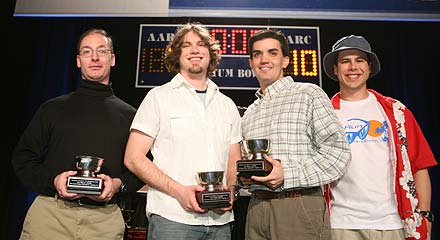
![]()

![]()
Congress Gazette
Tuesday, December 16, 2008
Covidien Sputum Bowl Winners
The 31st Annual Covidien Sputum Bowl® pitted the top 4 teams in both the National and Students division in final playoffs Monday night, and the winners are:

National Division
First Place: California

Students Division
First Place: Colorado

The AARC honored Jim Fenstermaker, our long-time Sputum Bowl master of ceremonies, at last night’s event after he announced his impending retirement. Jim has been the leader behind the Sputum Bowl since its inception in 1978. Thanks, Jim, for a job well done, and for all your hard work—and fun antics—over the years!
Roving Reporter:
Difficult Airway Management in Neonatal and Pediatrics Population: A Case-Based Approach
By Dawn Filippa, RRT, EMT-P
According to Steve Sittig, RRT-NPS, FAARC, from the Mayo Clinic in Rochester, MN, the American Association of Anesthesia defines airway difficulty as difficult mask ventilation and difficult tracheal intubation. Difficult tracheal intubation is tracheal intubation of more than three attempts or more than ten minutes for the procedure.
Neonatal and pediatric difficult airway management is challenging secondary to its rare, usually unanticipated occurrence, and needs to be achieved with little time to plan. Sittig had a cute analogy: The 200 Rule—during the difficult airway the heart rate of the practitioner and the patient together equals 200. He emphasized the importance of being prepared and knowing the equipment, and always having a backup plan.
If standard laryngoscopy is unsuccessful, having the backup airway within easy reach is a must. There are many backup airways for this patient population: LMA, Glidescope, King LT airway, and the lighted stylet to name a few.
Hypoxia during the intubation attempt is related to increased number of attempts, subsequent attempts with no change in techniques, inadequate oxygenation between attempts, aspiration, and traumatic edema from multiple attempts. Positioning the patient appropriately will maximize the first intubation attempt. Aligning the oral, pharyngeal, and laryngeal axis permits better visualization of the glottis and vocal cords and allows easier passage of the endotracheal tube. For children under one month of age, the head should be in a neutral position.
Problems associated with emergency pediatric airway management include: increased gastric distention, inability to intubate the trachea, inappropriate size of ETT, and failure to evaluate the placement of the ETT.
Roving Reporter:
24th Phil Kittredge Memorial Lecture: What is the Legacy of the NIH ARDSNet?
By Michael J. Hewitt, RRT-NPS, RCP, FAARC, FCCM

Richard Kallet
On Monday morning, a large audience was present to hear Richard Kallet, MS, RRT, FAARC, from San Francisco, CA, deliver the 24th Annual Phil Kittredge Memorial lecture. The topic, “What is the Legacy of the NIH ARDSNet?” is timely, as in March of 2009 it will be ten years since the ARDSNet work was published.
Kallet took time to honor the memory of Phil Kittredge, the late editor of Respiratory Care, acknowledging his influence on the profession, then launched into the topic at hand.
As one of the original investigators in the study on how to best manage the ventilators of those with ALI/ARDS, Kallet is very well versed in where we’ve been, where we are now, and where we need to go in this controversial but vital part of our practice. The talk was broken down into several parts, starting with a brief overview of the history of ARDS, from when it was first described in 1967 to date, including our ventilator practices both then and now. In addition, time was spent detailing the pitfalls, barriers, and accomplishments seen along the way.
It was clear to the attendees that this has been a long and difficult road, filled with challenges but also with still emerging data and changes around the ARDS process and how we manage those patients.
The various studies were reviewed, highlighting the important data resulting from each. Significant endpoints that were seen in more than one of these studies include:
- Application of 6-12 ml/kg Vt titrated to specific limits on plateau pressure resulted in an increase in PaO2 and improvement in compliance, but with no decrease in mortality.
- 6 ml/kg Vt with upward titration of PEEP yielded similar results as the previous application.
- Utilization of high dose steroids also yielded similar results but resulted in an increase in neuromuscular weakness.
Finally, a summary of what has happened thus far, as well as where we may consider going in the future, was discussed. Points included the need for changes in physician attitude regarding the development and utilization of therapist-driven protocols, as well as a continued effort to develop those protocols.
Thank You, Sponsors!
The AARC would like to recognize all of the companies that have sponsored events and services at this year’s Congress. Thank you, sponsors, for your support!
- Aerocrine, Inc.
- Boehringer Ingelheim
- Cardinal Health
- Covidien
- Discovery Laboratories, Inc.
- Draeger Medical Inc.
- GE Healthcare
- Ikaria
- Intersurgical Inc.
- Maquet, Inc.
- Masimo Corporation
- Monaghan Medical Corporation
- Nonin Medical Inc.
- OPTI Medical Systems Inc.
- Pharmaxis
- Roche Diagnostics
- Salter Labs
- Sepracor
See you next year in San Antonio

Congress 2009 is scheduled for San Antonio, TX, Dec. 5–8. Mark your calendars now, and log on to www.VisitSanAntonio.com/AARC2009 for more information.
Searching for paradise?

Meet us in Southwest Florida next summer for the AARC Summer Meetings at the Marco Island Marriott Beach Resort July 17–19.